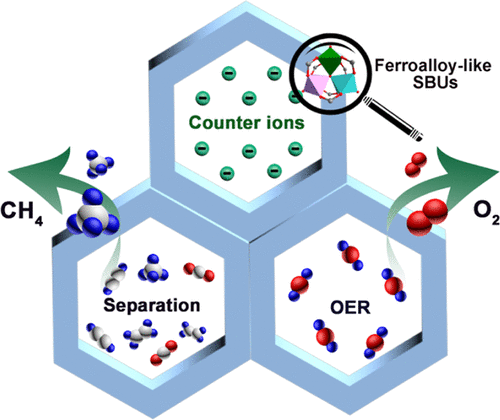当前位置:
X-MOL 学术
›
ACS Appl. Mater. Interfaces
›
论文详情
Our official English website, www.x-mol.net, welcomes your
feedback! (Note: you will need to create a separate account there.)
Mimic of Ferroalloy To Develop a Bifunctional Fe-Organic Framework Platform for Enhanced Gas Sorption and Efficient Oxygen Evolution Electrocatalysis.
ACS Applied Materials & Interfaces ( IF 8.3 ) Pub Date : 2020-01-17 , DOI: 10.1021/acsami.9b17492 Ying-Ying Xue 1 , Jian-Wei Zhang 1, 2 , Yong-Peng Li 1 , Hai-Peng Li 1 , Ying Wang 1 , Shu-Ni Li 1 , Yu-Cheng Jiang 1 , Man-Cheng Hu 1 , Quan-Guo Zhai 1
ACS Applied Materials & Interfaces ( IF 8.3 ) Pub Date : 2020-01-17 , DOI: 10.1021/acsami.9b17492 Ying-Ying Xue 1 , Jian-Wei Zhang 1, 2 , Yong-Peng Li 1 , Hai-Peng Li 1 , Ying Wang 1 , Shu-Ni Li 1 , Yu-Cheng Jiang 1 , Man-Cheng Hu 1 , Quan-Guo Zhai 1
Affiliation

|
It is well-known that the formation of ferroalloy with the addition of the second or third metal during the steel-making process usually can improve the performance of the iron. Inspired by ferroalloy materials, it is speculated that the pore environment, framework charge, and catalytic properties of metal-organic frameworks (MOFs) could be optimized dramatically via the introduction of ferroalloy-like inorganic building blocks. However, different to ferroalloy, the accurate integration of different metals into one MOF platform is still challenging. Herein, taking advantages of the good compatibility for metals in trigonal prismatic trinuclear cluster, a series of Fe-based alloy-like [M3O(O2C)6] motifs (M3 = Fe3, Fe1.5Ni1.5, Fe1.5Co1.5, Fe1.5Ti1.5, FeCoNi, and FeTiCo) are successfully generated, which further lead to a robust Fe-MOF material family (SNNU-5s). These multicomponent MOFs not only provide a good chance to explore the impact of pore environment on gas adsorption/separation but also offer an opportunity to the efficient electrocatalytic reaction directly. Accordingly, compared with the SNNU-5-Fe parent structure, the pore characters of heterometallic SNNU-5 MOFs are clearly regulated by the type of alloy-like building blocks. SNNU-5-FeTi displays more superior gas separation performance for CO2/CH4, C2H2/CH4, C2H4/CH4, and C2H2/CO2 gas mixtures. What is more, benefited from the multimetallic active sites and their catalytic synergy, FeCoNi-ternary alloy-like cluster-based SNNU-5 MOF material exhibits an exceptional oxygen evolution reaction activity in aqueous solution at pH = 13, which delivers a low overpotential (ηj=10 = 317 mV), a fast reaction kinetics (Tafel slope = 37 mV dec-1), and excellent catalytic stability. This facile multialloy-like building block strategy holds promise to accurately design and improve the performance of MOFs, as well as open an avenue to understand the related mechanisms.
中文翻译:

模拟铁合金,开发双功能铁有机骨架平台,以增强气体吸附和高效的析氧电催化作用。
众所周知,在炼钢过程中添加第二或第三种金属形成铁合金通常可以改善铁的性能。受铁合金材料的启发,推测可以通过引入类似铁合金的无机结构单元来显着优化孔隙环境,骨架电荷和金属有机骨架(MOF)的催化性能。但是,与铁合金不同,将不同金属准确地集成到一个MOF平台中仍然具有挑战性。在此,利用与三棱柱形三核簇中金属的良好相容性,产生了一系列铁基合金状[M3O(O2C)6]基序(M3 = Fe3,Fe1.5Ni1.5,Fe1.5Co1.5, Fe1.5Ti1.5,FeCoNi和FeTiCo)已成功生成,这进一步导致了坚固的Fe-MOF材料家族(SNNU-5s)。这些多组分MOF不仅为探索孔隙环境对气体吸附/分离的影响提供了一个很好的机会,而且还为直接进行有效的电催化反应提供了机会。因此,与SNNU-5-Fe母体结构相比,杂金属SNNU-5 MOF的孔特征明显受合金状结构单元类型的调节。SNNU-5-FeTi对CO2 / CH4,C2H2 / CH4,C2H4 / CH4和C2H2 / CO2气体混合物显示出更优异的气体分离性能。而且,得益于多金属活性位及其催化协同作用,FeCoNi-三元合金簇状SNNU-5 MOF材料在pH = 13的水溶液中表现出优异的析氧反应活性。它具有低的超电势(ηj= 10 = 317 mV),快速的反应动力学(Tafel斜率= 37 mV dec-1)和出色的催化稳定性。这种简便的类似多合金的构建块策略有望准确地设计和改善MOF的性能,并为了解相关机制开辟一条道路。
更新日期:2020-01-17
中文翻译:

模拟铁合金,开发双功能铁有机骨架平台,以增强气体吸附和高效的析氧电催化作用。
众所周知,在炼钢过程中添加第二或第三种金属形成铁合金通常可以改善铁的性能。受铁合金材料的启发,推测可以通过引入类似铁合金的无机结构单元来显着优化孔隙环境,骨架电荷和金属有机骨架(MOF)的催化性能。但是,与铁合金不同,将不同金属准确地集成到一个MOF平台中仍然具有挑战性。在此,利用与三棱柱形三核簇中金属的良好相容性,产生了一系列铁基合金状[M3O(O2C)6]基序(M3 = Fe3,Fe1.5Ni1.5,Fe1.5Co1.5, Fe1.5Ti1.5,FeCoNi和FeTiCo)已成功生成,这进一步导致了坚固的Fe-MOF材料家族(SNNU-5s)。这些多组分MOF不仅为探索孔隙环境对气体吸附/分离的影响提供了一个很好的机会,而且还为直接进行有效的电催化反应提供了机会。因此,与SNNU-5-Fe母体结构相比,杂金属SNNU-5 MOF的孔特征明显受合金状结构单元类型的调节。SNNU-5-FeTi对CO2 / CH4,C2H2 / CH4,C2H4 / CH4和C2H2 / CO2气体混合物显示出更优异的气体分离性能。而且,得益于多金属活性位及其催化协同作用,FeCoNi-三元合金簇状SNNU-5 MOF材料在pH = 13的水溶液中表现出优异的析氧反应活性。它具有低的超电势(ηj= 10 = 317 mV),快速的反应动力学(Tafel斜率= 37 mV dec-1)和出色的催化稳定性。这种简便的类似多合金的构建块策略有望准确地设计和改善MOF的性能,并为了解相关机制开辟一条道路。











































 京公网安备 11010802027423号
京公网安备 11010802027423号